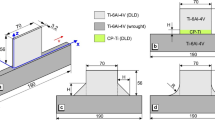Abstract
In order to describe the thermal dynamics behaviour in direct laser fabrication (DLF), a 3D finite element temperature field model is proposed to be built/developed based on global model and sub-model pattern. The global model exhibits the heat conduction characteristics of parts in the whole thermal history according to scanning path planning. Contact pairs and gap elements, which consider the effect of the temperature and porosity-dependent thermal conduction, are designed in the model to explain powder-to-solid intrinsic transition. In addition, the elements removed and reactivated technology is applied in the model so as to embody the material stepwise increasing feature. A laser-repairing case developed by ABAQUS demonstrates the global model’s thermal history, and the influence of non-linear behaviour of thermal properties in pure nickel on the temperature distribution is estimated as well. Adopting the thermal physical parameters with solid–liquid phase change will make the melted pool temperature higher than that where the solid–liquid phase change parameters are not considered.
Similar content being viewed by others
References
Sandia National Laboratories (2008) Laser engineered net sha**. Available at http://www.sandia.gov/mst/technologies/net-sha**.html
Yakovlev A, Trunova E, Grevey D, Pilloz M, Smurov I (2005) Laser-assisted direct manufacturing of functionally graded 3D objects. Surf Coat Technol 190:15–24 doi:10.1016/j.surfcoat.2004.07.070
Pinkerton AJ, Li L (2005) Direct additive laser manufacturing using gas- and water-atomised H13 tool steel powders. Int J Adv Manuf Technol 25:5–6 doi:10.1007/s00170-003-1844-2
Wang F, Mei J, Wu X (2006) Microstructure study of direct laser fabricated Ti alloys using powder and wire. Appl Surf Sci 253:1424–1430 doi:10.1016/j.apsusc.2006.02.028
Banerjee R, Brice CA, Banerjee S, Fraser HL (2003) Microstructural evolution in laser deposited Ni-25at.% Mo alloy. Mater Sci Eng A 347:1–4 doi:10.1016/S0921-5093(02)00603-2
Griffith ML, Schlienger ME, Harwell LD, Oliver MS, Baldwin MD, Ensz MT, Essien M, Brooks J, Robino CV, Smugeresky JE, Hofmeister WH, Wert MJ, Nelson DV (1999) Understanding thermal behavior in the LENS process. Mater Des 20:107–113
Dai K, Shaw L (2001) Thermal and stress modeling of multi-material laser processing. Acta Mater 49:4171–4181 doi:10.1016/S1359-6454(01)00312-3
Dai K, Shaw L (2004) Thermal and mechanical finite element modeling of laser forming from metal and ceramic powders. Acta Mater 52:69–80 doi:10.1016/j.actamat.2003.08.028
Matsumoto M, Shiomi M, Osakada K, Abe F (2002) Finite element analysis of single layer forming on metallic powder bed in rapid prototy** by selective laser processing. Int J Mach Tools Manuf 42:61–67 doi:10.1016/S0890-6955(01)00093-1
Chung H, Das S (2004) Numerical modeling of scanning laser-induced melting, vaporization and resolidification in metals subjected to step heat flux input. Int J Heat Mass Transfer 47:4153–4164 doi:10.1016/j.ijheatmasstransfer.2004.05.003
Kolossov S, Boillat E, Glardon R (2004) 3D FE simulation for temperature evolution in the selective laser sintering process. Int J Mach Tools Manuf 44:117–123 doi:10.1016/j.ijmachtools.2003.10.019
Longtin JP, Jikata KH, Ogawa K (1999) Laser induced surface tension driven flows in liquids. Int J Heat Mass Transfer 42:85–93 doi:10.1016/S0017-9310(98)00134-3
Peng XF, Lin XP, Lee DJ, Yan Y, Wang BX (2001) Effects of initial molten pool and Marangoni flow on solid melting. Int J Heat Mass Transfer 44:457–470 doi:10.1016/S0017-9310(00)00070-3
Yang LX, Peng XF, Wang BX (2001) Numerical modeling and experimental investigation on the characteristics of molten pool during laser processing. Int J Heat Mass Transf 44:4465–4473 doi:10.1016/S0017-9310(01)00086-2
Pinkerton AJ, Li L (2004) Modeling the geometry of a moving laser melt pool and deposition track via energy and mass balances. J Phys D Appl Phys 37:1885–1895 doi:10.1088/0022-3727/37/14/003
Li JF, Li L, Stott FH (2004) A three-dimensional numerical model for a convection–diffusion phase change process during laser melting of ceramic materials. Int J Heat Mass Transfer 47:5523–5539 doi:10.1016/j.ijheatmasstransfer.2004.07.024
Keller M, Wilhelm S (2006) 3-D simulation of laser additive manufacturing using ABAQUS. Available at http://www.abaquscentral.com/downloads/ACUC_2005/Matt_Keller/Keller_Presentation.pdf
ABAQUS Inc. (2004) ABAQUS version 6.5 documentation: theory manual.. ABAQUS Inc., USA
Mills KC (2002) Recommended values of thermophysical properties for selected commercial alloys. Woodhead, Cambridge
Author information
Authors and Affiliations
Corresponding author
Rights and permissions
About this article
Cite this article
Yang, J., Wang, F. 3D finite element temperature field modelling for direct laser fabrication. Int J Adv Manuf Technol 43, 1060–1068 (2009). https://doi.org/10.1007/s00170-008-1785-x
Received:
Accepted:
Published:
Issue Date:
DOI: https://doi.org/10.1007/s00170-008-1785-x




